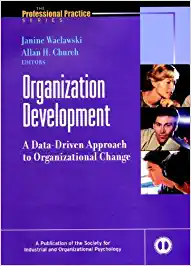Organization Development, Organization Development Definition, Organization Development Meaning
Organizational Development (OD) can be defined as the process of hierarchical change in the organization. Organizational Development (OD) is directly correlated with behavioral science which is not a matter of an overnight transformation process. It should be implemented in the organization in a systematic way, so that organization can be benefited from the process. Key concepts of OD theory include organizational culture, organizational climate, and organizational strategy which emerged from human relations studies in the 1930s.
Objectives of Organizational Development
Organizational development strategies help organizations to achieve their objectives and goals of the organization. There are many objectives of organizational development which can be summarized below-
- To align employees with the organization’s mission and vision,
- To handle organizational conflict in an effective manner,
- To increase the satisfaction and commitment level of the employees,
- To increase the interpersonal trust level of the employees,
- To solve problems effectively rather than neglect,
- To increase employee collaboration etc.
Benefits of Organization Development, What is the need of Organization Development
Organizational development enables an organization to be equipped with the right capabilities to adapt to a changing environment. The practice of OD increases organizational productivity and overall efficiency which ensures organizational growth. 7 key benefits of organizational development include the following:
Continuous Development
Organizations can enjoy the flavor of sustainable growth or development when they practice or participate in organizational development. Organizational development practice allows an organization to continuously improve in productivity. Organizational development (OD) allows regular evaluation of strategies to ensure the effectiveness of the OD system. As a result, both internal and external changes occurred for the betterment of employees and the organization.
Effective Business Expansion
The practice of OD allows employees to expand their businesses in new areas and target new customers always. An organization expands its business when it runs through OD practices. Because future business expansion depends on the vision of the future operation of the organization. OD helps employees to be aligned with the vision of the organization and they try to contribute to the effective business expansion of the organization.
Increased Effective Communication
Effective communication systems and cultures are established through the practicing organizational development strategy. OD increases the effectiveness of communication as well as enables organizations to develop efficient communication styles. This system helps employees to be aligned with the mission and vision of the company. An open communication system is established through OD which helps employees to understand the importance of change in the organization for better growth and development in near future.
Employee Growth
Employee growth initiatives for employees are always treated as the best practice in OD. When an organization emphasized organizational development, ultimately employees’ communication strategies improved and they can easily fit themselves with the changing culture. Organizations arrange different types of outbound programs to improve employee morale and make them skilled as well. This initiative not only helps in organizational development but also increases employee growth.
Improvement of Products and Services
Due to organizational development, products and service levels improved as lots of innovation take place in the workplace. Organizational change happens and employees feel motivated to contribute to organizational growth.
Increased Organizational Profit
Organizational development ensures increased organizational profit through the improvement of products and services. Organizational development practices ensure the reduction of employee absenteeism and turnover, multiple unnecessary cost reductions, and ultimately productivity and profit increases. Employer satisfaction increased due to an increase in organizational profit through quality products and services.
Capacity Building
Organizational development (OD) strategies help organizations to build the capacity of the employees through different kinds of training and workshop. As requirements are being changed over time, an organization should keep its employees updated according to trends. OD makes employees competent for the growing market.
The different small and medium-scale projects can be run under OD strategy to increase employee competency and overcome weaknesses.
Cost Reduction
Employee satisfaction is increased through OD. This OD process helps to reduce employee absenteeism and turnover which reduces the costs related to recruitment. OD strategy focuses on continuous improvement that results in improved productivity and reduces operational costs.
Organization Development Techniques, Organization Development Process, Process of Organization Development
The organizational development process is a systematic and research-based series of steps. The steps of organizational development include the following:
- Problem Identification: Problems should identify which are aligned with business goals. Companies can use a data-driven approach to identify problems through formal surveys and employee feedback. The organization should collect or identify problems according to organizational development strategies and these should be considered as a scope of opportunity.
- Situational Assessment: This is the formal assessment of problems through documentation review, focus group discussion, individual consultation, survey, etc. The purpose of situational assessment is to identify the reasons behind the problems and find out the barriers to improvement and solutions. This is considered as fact gathering and assessment.
- Action Plan Preparation: This is the most important and longest step of the organizational development process. Here, the organization prepares an action plan to overcome identified problems. The action plan should address specific actions with a timeline and dissemination of responsibility. Actions should be SMART in an action plan to ensure targeted output.
- Implementation of Action Plan: This is the stage of putting a plan into action. Strategic steps need to take for the proper implementation of the action plan. Continuous monitoring, feedback, and communication can increase the effectiveness of this implementation step.
- Data Gathering: Company has to gather all data to know the effectiveness of changes toward business goals. This will help to manage the overall process effectively, so that company can know and evaluate its initiatives against identified problems.
- Evaluation of Result: It’s the step of evaluating employee feedback, whether changes can effectively meet organizations’ business goals or not. This process helps organizations to think differently for overcoming all obstacles. Evaluation of results should process strategically to get optimum results.
- Feedback and Adaptation: Feedback collection sources and processes need to be authentic for an accurate result. Otherwise, falsified data may be gathered. The company should take corrective action based on feedback. If the analysis report or feedback is observed as successful then the company can keep the current plan in its continuation plan.
To Read more such informative Blogs Click Here
hradvosrs4u Blogs
Challenges in Organizational Development
There are many benefits of OD, but organizations have to face some challenges for the successful implementation of OD. Some common challenges of the organizational development process include the following:
- Fear of the unknown: Employees get fear when an organization tries to initiate new action. They think that their job is not secure and it will make them jobless. As a result, they didn’t involve themselves completely.
- Improper Communication: New initiatives can’t see the light horizon due to the improper communication system of the organization. It may create difficulties in the case of OD implementation.
- Lack of understanding: Some employees of the organization didn’t show a positive attitude in case of organizational change which is considered a challenge of OD. Proper training and counseling can change employee mindset which helps to improve organizational culture.
- Stress: In absence of proper support for the implementation, employees may feel stress. Employers should take only real action. It helps organizations to remove employees’ stress or burnout and ensure work-life balance.
- Insufficient Leadership: This is considered a challenge of organizational development strategy. Because OD implementation is almost impossible without proper leadership skills and practices.
Organization Development pdf

This hands-on guide–for planning, diagnosing, implementing, and evaluating organization development interventions–gives scientifically based information, tools, suggestions, and guidelines for those who must manage the human side of change.
In Organization Development, leading experts and pioneers:
* Present a unified framework for understanding OD
* Demonstrate OD’s effectiveness for improving individual and organizational performance
* Specify what types of goals, values, practices, and interventions should (and should not) represent OD



Add a Comment